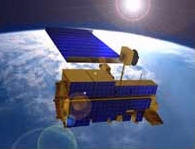A satellite is an object that orbits a larger object, such as a planet. The earth’s moon is an example of a natural satellite; weather satellites are the result of human ingenuity. The launch of the Russian satellite Sputnik in 1957 initiated our exciting exploration of space. Scientists in the United States put instruments on spacecrafts and launched the first climate satellite in 1959 (Explorer VII) and the first weather satellite, Tiros I, in 1960.
Today, satellite technology is ubiquitous in modern society. Along with enabling communication and navigation, satellite images of cloud patterns, weather systems and storm tracks are routinely displayed during television weather forecast and instantly available over the world wide web.
| In this lesson you will learn:
Time requirement This lesson will take about 30 minutes to complete |
|

